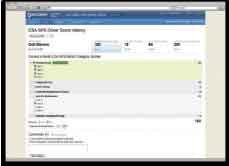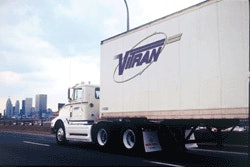Constant pressure
Tire pressure monitoring systems give instant visibility to drivers, managers
By Aaron Huff
Maximizing tire life and improving fuel economy are pressing issues for fleet maintenance managers. Using technology to monitor tire pressure continuously can assist in both efforts.
 Stemco’s AirBat RF product line includes a driver alert system with an in-cab display and a handheld reader that a technician could use to monitor tire pressures.
Stemco’s AirBat RF product line includes a driver alert system with an in-cab display and a handheld reader that a technician could use to monitor tire pressures.A number of fleets use automatic tire inflation systems to keep tire pressure constant. These systems also can alert drivers and fleet managers – via integration with onboard computing systems – to fast leaks and other problems that require immediate attention.
When integrated with the Meritor Tire Inflation System by P.S.I., Qualcomm’s Trailer Tracks Series provides trailer management capabilities that allow customers to pinpoint tire pressure problems before an on-road incident occurs. Customers receive an automatic alert indicating that the tire pressure threshold has been breached.
By comparison, tire pressure monitoring systems are more economical and easier to install, but they require human intervention to correct problems with tire pressure. These systems come in many varieties and fit a wide scope of user requirements, but even the most advanced TPMS can be purchased for about $1,000. Once installed, they can operate maintenance-free for the entire trade cycle of equipment, normally three to five years.
Sensor configurations
All TPMS use sensors mounted on the wheel stem or valve cap. The durability and functionality of these sensors are key considerations when choosing a TPMS.
A unique feature of the TireStat system from Mobile Awareness is a sensor with a “flow-through” design that allows the user to add or deplete air without removing the sensor. With this design, users can mount the sensor with thread locking compound to ensure an airtight seal to prevent leaks and theft.
Some sensors are designed to flash an LED when air pressure drops below a set point. Others are equipped with wireless RF communications to feed information to in-cab driver displays and portable devices.
Stemco’s BatRF family of tire pressure monitoring products offers several types of configurations. A wheel-mounted sensor flashes when a tire is underinflated, and its AirBat RF product line includes a driver alert system with an in-cab display and a handheld reader that a technician could use to monitor tire pressures.
Stemco recently added a new feature to its AirBat RF handheld called “low tire log.” The information shows, to the hour, how long the tire has been underinflated. With this information, a technician can diagnose the cause of an underinflated tire. If the tire has been low for an extended period, pressure probably has been leaking out at the normal rate of 2 psi per month.
All-in-one displays
Some TPMS suppliers have created in-cab displays with a full vehicle schematic for each tire position, giving location and pressure data for all tires. For systems that use sensors with RF technology, these displays can be portable and work the same both inside and outside the vehicle.
By integrating with an onboard system, fleets can have alerts sent to anyone.
To eliminate extra devices in the cab and to gain remote visibility to tire conditions, fleets can use a TPMS that integrates with their existing onboard computing platforms. By integrating with an onboard system, fleets also can have alerts or warnings sent to any party it deems necessary, including the fleet dispatcher and maintenance department.
PeopleNet’s BLU In-cab PC can be equipped with a wireless electronic remote TPMS from PressurePro to monitor and display tire pressures to drivers on demand, whether moving or stationary. Fleet managers can receive alerts to low tire pressure problems.
Rand McNally’s Truck PC, powered by DriverTech, integrates with the Doran TPMS. The Doran system sends information directly to the TruckPC, where it is displayed for the driver to monitor in real time. Real-time notifications also can be sent to the carrier via e-mail and text message for low tire pressure, slow leaks and fast leaks.
Besides seeking to improve tire life and fuel mileage, TPMS also can help fleets proactively address safety and compliance challenges associated with tire conditions. The Federal Motor Carrier Safety Administration is cracking down on truck, tractor and trailer tire conditions with its Compliance Safety Accountability (CSA) criteria. Under the new guidelines, any roadside inspection that lists a tire maintenance violation will remain on the carrier’s profile for two years and the driver’s profile for three years.
IN BRIEF
* Comdata (www.comdata.com), a provider of electronic payment technology, launched NextGen Connection for Permits, an online platform that provides capabilities for ordering, tracking and managing permits.
* Intermec (www.intermec.com) released the 70 Series, a portfolio of ultrarugged mobile computers that comprises four products over one platform.
* Freight transportation software developer SMC3 (www.smc3.com) and routing, mileage and mapping software developer ALK Technologies (www.alk.com) announced the creation of a seamless interface between ALK’s PC Miler Web Services and SMC3’s RateWare XL rating product.
* AT&T released a new offering that enables transportation companies to capture location information from drivers’ handsets – regardless of hardware or wireless service provider – using a technology developed by TechnoCom Wireless called LocationSmart.
* USA Truck selected SkyBitz
(www.skybitz.com) for its Gemini GLS400 trailer-tracking mobile terminals plus cargo sensors. The technology will be installed on more than 6,000 trailers beginning during the first quarter of 2011.
* Par Logistics Management Systems (www.parlms.com) was selected by Grand Island, Neb.-based Grand Island Express to provide real-time monitoring and control for its refrigerated fleet of 225 trailers.
* LeanLogistics (www.leanlogistics.com), a provider of software-as-a-service transportation technology and supply chain services, released On-Demand TMS version 10.3.0, an update of its transportation management system.
Qualcomm debuts CSA Safety Performance Service
Qualcomm announced the commercial availability of the CSA Safety Performance Service designed to provide carriers with a tool to manage performance related to the Federal Motor Carrier Safety Administration’s new Compliance Safety Accountability (CSA) Safety Measurement System scoring methodology.
 Qualcomm’s CSA Safety Performance Service is designed to integrate data from the CSA SMS and correlate relevant Qualcomm services data to provide a comprehensive analysis of driver- and fleet-specific data.
Qualcomm’s CSA Safety Performance Service is designed to integrate data from the CSA SMS and correlate relevant Qualcomm services data to provide a comprehensive analysis of driver- and fleet-specific data.The CSA Safety Performance Service is designed to integrate data from the CSA SMS and correlate relevant Qualcomm services data – including hours-of-service violations, critical event reporting and performance monitoring – to provide a comprehensive analysis of driver- and fleet-specific data.
Powered by FleetRisk Advisors’ The Driving Center, the service is designed to help fleets improve their SMS scores and reduce inspections, violations and accidents. Qualcomm says carriers who implement the CSA Safety Performance Service have access to comprehensive views of a fleet’s performance across FMCSA’s seven Behavior Analysis and Safety Improvement Categories (BASICs), tools to identify potential problem areas in future inspections, driver coaching scripts to address identified issues, and detailed tracking of the remediation process.









